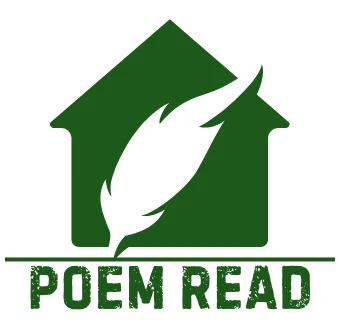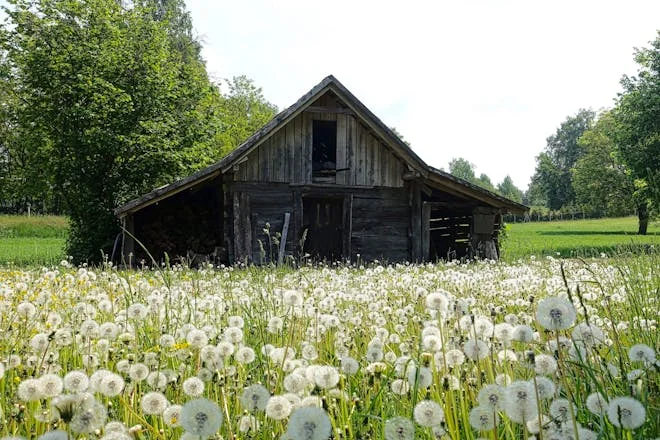
Let’s set the stage for our exploration of A. E. Housman’s evocative poem, “Farewell to Barn and Stack and Tree.” Imagine standing on the threshold of departure, your gaze lingering on familiar landscapes—the barn, the haystacks, the sun-kissed hills.
But this farewell is no ordinary parting; it carries the weight of guilt, irreversible choices, and the ache of loss. As we step into Housman’s world, we’ll unravel the layers of emotion, understand poetic techniques, and discover why this timeless work continues to resonate with readers across generations. Welcome to a journey of heartache and reflection—a farewell that echoes through the ages.
Farewell to Barn and Stack and Tree
“Farewell to barn and stack and tree,
Farewell to Severn shore.
Terence, look your last at me,
For I come home no more.”
“The sun burns on the half-mown hill,
By now the blood is dried;
And Maurice amongst the hay lies still
And my knife is in his side.”
“My mother thinks us long away;
‘Tis time the field were mown.
She had two sons at rising day,
To-night she’ll be alone.”
“And here’s a bloody hand to shake,
And oh, man, here’s good-bye;
We’ll sweat no more on scythe and rake,
My bloody hands and I.”
“I wish you strength to bring you pride,
And a love to keep you clean,
And I wish you luck, come Lammastide,
At racing on the green.”
“Long for me the rick will wait,
And long will wait the fold,
And long will stand the empty plate,
And dinner will be cold.”
Content
- About the Author: A.E. Housman
- Subject of Farewell to Barn and Stack and Tree
- Context of Farewell to Barn and Stack and Tree
- Persona, Narrative and Setting of “Farewell to Barn and Stack and Tree”
- Theme of Farewell to Barn and Stack and Tree
- Tone of Farewell to Barn and Stack and Tree
- Form and Structure of Farewell to Barn and Stack and Tree
- Line-by-Line Analysis of Farewell to Barn and Stack and Tree
- Poetic and Literary Devices Used in Farewell to Barn and Stack and Tree
- Commonly Asked Questions
- Implications and Meanings of Farewell to Barn and Stack and Tree
- Interactive Summary of Farewell to Barn and Stack and Tree
About the Author: A.E. Housman
A.E. Housman, born Alfred Edward Housman, was an English poet and scholar. He was born on March 26, 1859, in Worcestershire, England. His most famous work, “A Shropshire Lad,” expresses romantic pessimism in a spare, simple style. Personal struggles, such as unrequited love and the loss of his mother, characterized Housman’s life.
Despite his brilliance as a scholar, he failed his final examination at Oxford due to emotional troubles. His poems, set in the fictional Shropshire countryside, resonate with themes of early death, longing, and the passage of time. Housman’s impact extends beyond poetry; his editions of Latin texts remain authoritative, and he is regarded as one of the greatest classicists of his time.
Subject of Farewell to Barn and Stack and Tree
The subject of “Farewell to Barn and Stack and Tree” is a heart-wrenching narrative of fratricide and its aftermath. The speaker, having accidentally killed his brother Maurice in a wheat field, is compelled to leave everything behind: his home, his family, and his former life. The poem does not give the specifics of why the incident occurred, leaving the reader to ponder the circumstances that led to such a devastating outcome.
At the heart of the poem is the speaker’s sense of loss and guilt. He is not only mourning the death of his brother but also the loss of his place in the world. The subject is thus twofold: it is about the irreversible act of violence and its emotional and existential repercussions. The speaker’s farewell is not just to the physical structures of the farm but to his entire past and identity.
The poem captures the finality of departure and the solitude that follows. It speaks to the universal themes of regret, the burden of guilt, and the longing for forgiveness and redemption. Housman’s portrayal of the speaker’s turmoil invites readers to reflect on the fragility of life and the intense effects our actions can have on ourselves and others.
Context of Farewell to Barn and Stack and Tree
“Farewell to Barn and Stack and Tree” is set in the pastoral landscape of the English countryside, a setting that often serves as the backdrop for Housman’s poetry. The poem is steeped in the rural traditions and natural beauty of Shropshire, which Housman immortalized in his collection “A Shropshire Lad.” This particular poem, however, juxtaposes the picturesque scenery with a dark narrative, creating a stark contrast that heightens the emotional impact of the story.
The context is not merely the physical setting but also the social and familial dynamics at play. The poem reflects on the consequences of a tragic incident within a close-knit community, where everyone’s lives are intertwined with the land they work on. It’s a world where the rhythms of nature dictate the flow of life and where an event like the one described in the poem can disrupt the very fabric of existence.
The poem was published in the late 19th century, a time when the world was on the cusp of modernity, yet many rural communities still held onto traditional ways of life. Housman’s work often grapples with this tension between the old and the new, the timeless and the transient.
Persona, Narrative and Setting of “Farewell to Barn and Stack and Tree”
Persona
The persona in the poem adopts a reflective and introspective tone, expressing emotions of farewell, regret, and longing. This persona seems to be a participant in a tragic event, possibly grappling with guilt or sorrow over what has transpired. The speaker’s voice carries a sense of resignation and acceptance of the inevitable changes, adding depth to the emotional landscape of the poem.
Narrative
The narrative of the poem unfolds through a series of reflections and observations, depicting a departure from familiar surroundings and a sense of loss. It weaves together themes of departure, violence, familial duty, and the passage of time. Through the narrative, the speaker’s experiences and emotions are conveyed, inviting the reader to contemplate themes of mortality, human connection, and the impact of change.
Setting
The setting of the poem is primarily rural, evoking images of barns, fields, and natural landscapes such as the Severn shore. These settings serve as symbolic backdrops to the unfolding events, emphasizing the contrast between peaceful nature and the harsh realities of life and death. The pastoral setting also enhances the themes of labor, familial ties, and the cyclical nature of existence, creating a rich background against which the narrative unfolds.
Theme of Farewell to Barn and Stack and Tree
The predominant theme of the poem is guilt and its inescapable shadow that looms over the speaker’s life. The act of fratricide, whether accidental or intentional, casts a long, dark shadow over the speaker’s existence, compelling him to leave behind everything he knows and loves. This theme is universal, touching on the human experience of living with the consequences of one’s actions, especially when they result in irreversible harm to others.
Housman masterfully explores the complexity of guilt—not just as a personal emotion but as a force that reshapes one’s identity and future. The speaker’s farewell is laden with the weight of his guilt, which is so powerful that it severs his ties to his home and family, leaving him in a self-imposed exile.
Tone of Farewell to Barn and Stack and Tree
The tone of the poem is a mixture of resignation and melancholy. There is a sense of inevitability in the speaker’s voice, a resignation to the fact that there is no undoing what has been done. The melancholic undertone reflects the speaker’s deep sorrow for the loss of his brother and the life he once had. The tone is not one of dramatic despair but rather a quiet, introspective lamentation.
Housman’s use of simple language and rural imagery serves to amplify the emotional resonance of the poem. The tone is not overly dramatic; it is the subtlety of the speaker’s expressions of regret and longing that makes the poem so powerful. The understated nature of the language mirrors the speaker’s internal struggle as he grapples with his emotions in the face of a life-altering event.
Every farewell in the poem has a hint of regret from the speaker, and the tragedy that has occurred has clouded every memory of the past. The tone, therefore, is not just about the sadness of parting but also about the complexity of human emotions when confronted with the consequences of one’s actions.
Form and Structure of Farewell to Barn and Stack and Tree
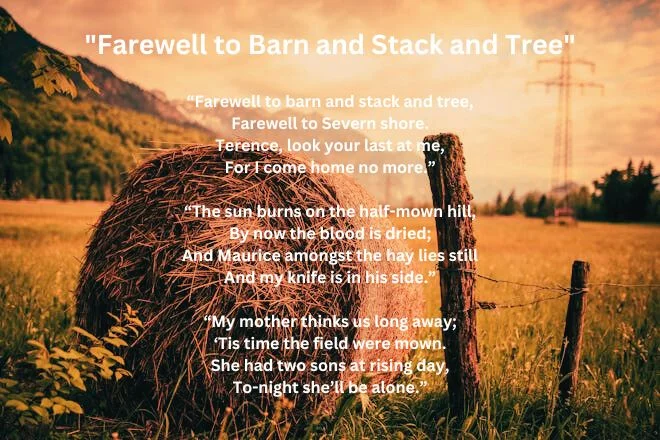
Structure Analysis
- Quatrains: The poem’s structure is built on quatrains, which are traditionally associated with narrative poetry. This form is particularly effective for storytelling, as it provides a clear and concise framework for each event or thought. Housman’s use of quatrains suggests a controlled approach to the narrative, reflecting the speaker’s attempt to manage his overwhelming emotions.
- Line Length: Each line in the quatrains is metered with a similar number of syllables, creating a harmonious flow. Despite the disruption that the tragic event caused, this regularity in line length mirrors the cycles of nature and life that the poem’s setting evokes.
Rhyme Scheme Analysis
The rhyme scheme in A. E. Housman’s poem “Farewell to Barn and Stack and Tree” plays a crucial role in the poem’s structure and its emotional resonance. Let’s analyze the specifics of the rhyme scheme and its effects:
The poem follows a traditional ABAB pattern, which means that the first and third lines of each quatrain rhyme with each other, as do the second and fourth lines. This pattern is consistent throughout the poem’s six stanzas.
For example, in the first stanza:
- “Farewell to barn and stack and tree,” (A)
- “Farewell to Severn shore.” (B)
- “Terence, look your last at me,” (A)
- “For I come home no more.” (B)
This ABAB pattern creates a sense of order and predictability, which contrasts with the chaos and turmoil of the poem’s subject matter. The rhyme scheme also contributes to the musicality of the poem, making it more memorable and impactful.
Effects of the Rhyme Scheme
- Musical Quality: The rhyming lines produce a lyrical, song-like quality that can make the poem more engaging and easier to remember. It adds a layer of beauty to the otherwise tragic narrative.
- Emotional Impact: The regularity of the rhyme scheme provides a comforting structure, which can be seen as a counterbalance to the emotional upheaval the speaker experiences. It’s as if the form of the poem offers a container for the speaker’s grief and guilt.
- Narrative Flow: The rhymes help to propel the narrative forward, guiding the reader from one stanza to the next. The end rhyme acts as a cue for the reader to move on, creating a sense of progression through the poem.
- Contrast and Emphasis: By choosing specific words to rhyme, Housman can emphasize certain images or ideas. The rhymes draw attention to the words and can create connections between different parts of the poem.
Impact Analysis
- Narrative Progression: The quatrains serve as individual units of meaning, each contributing to the overall narrative arc. The progression from one quatrain to the next is seamless, guiding the reader through the speaker’s journey from shock to acceptance.
- Imagery and Pacing: The consistent structure allows Housman to pace the imagery and revelations in a way that builds tension and emotional impact. The snapshots captured in each quatrain are vivid and poignant, leaving lasting impressions on the reader.
- Enjambment and Punctuation: While the stanzas are neatly structured, Housman employs enjambment and varied punctuation to create pauses and breaks within the rhythm. These pauses serve as moments for reflection, both for the speaker and the reader, highlighting key moments and emotions in the narrative.
Meter
The meter of A.E. Housman’s “Farewell to Barn and Stack and Tree” predominantly follows a pattern of iambic tetrameter. This means that each line typically consists of four metrical feet, with each foot containing an unstressed syllable followed by a stressed syllable (da-DUM). This regular iambic meter contributes to the poem’s musicality and rhythmic flow, enhancing the emotional impact of the speaker’s farewell and reflections.
In summary, the form and structure of “Farewell to Barn and Stack and Tree” are meticulously crafted to support the poem’s themes and emotional tone. Housman’s choices in rhyme, meter, and stanzaic form work in concert to deliver a powerful and moving narrative that stays with the reader long after the final line.
Line-by-Line Analysis of Farewell to Barn and Stack and Tree
First Stanza
"Farewell to barn and stack and tree,
Farewell to Severn shore.
Terence, look your last at me,
For I come home no more."
In these opening lines, the speaker bids farewell to the familiar rural landscape, symbolized by the barn, stack, tree, and Severn shore. The mention of Terence suggests a personal connection—someone the speaker wants to remember before their departure.
“Farewell to barn and stack and tree,”
The poem begins with an emotional farewell to familiar sights of the countryside. The “barn,” “stack,” and “tree” symbolize the agricultural life the speaker is leaving behind. The repetition of “farewell” emphasizes the finality of this departure.
“Farewell to Severn shore.”
The “Severn shore” refers to the banks of the river Severn, which is the longest river in Great Britain. Mentioning a specific location adds a layer of realism to the poem, grounding the speaker’s farewell in a tangible place.
“Terence, look your last at me,”
The speaker addresses someone named Terence, asking for a final look. This personalizes the farewell, suggesting a close relationship between the speaker and Terence. It also introduces the idea that the speaker is leaving not just places but people as well.
“For I come home no more.”
The final line of the stanza reveals the permanence of the speaker’s departure. The phrase “no more” underscores the irreversible nature of his leaving, hinting at a deeper reason behind this farewell that goes beyond a simple departure.
The first stanza sets the tone for the entire poem, establishing a sense of loss and finality. It introduces the reader to the speaker’s emotional state and the gravity of his situation. The stanza is rich with imagery and personal connection, inviting the reader to immerse deeper into the narrative that unfolds in the subsequent stanzas.
Second Stanza
"The sun burns on the half-mown hill,
By now the blood is dried;
And Maurice amongst the hay lies still,
And my knife is in his side."
Here, the speaker describes a scene where the sun shines on a hill that has been partially mowed. The mention of blood and Maurice’s lifeless body suggests violence and death. The speaker reveals their involvement in Maurice’s demise, emphasizing the darker aspects of their experiences.
“The sun burns on the half-mown hill,”
The imagery here is vivid and evocative. The “half-mown hill” suggests a landscape in transition—partly harvested, partly untouched. The sun’s burning intensity contrasts with the violence that has occurred. The hill becomes a witness to the tragedy.
“By now the blood is dried;”
The matter-of-fact tone underscores the grim reality. The blood, once fresh and flowing, has now dried. This line emphasizes the irreversible nature of the event and the passage of time.
“And Maurice amongst the hay lies still,”
The name “Maurice” personalizes the tragedy. He is not just a casualty, but an individual with a name. The word “still” suggests both physical stillness and emotional weight.
“And my knife is in his side.”
The direct admission of guilt is chilling. The speaker acknowledges that he is responsible for Maurice’s death. The placement of the knife on Maurice’s side is a powerful image, emphasizing the intimacy and brutality of the act.
In this stanza, Housman continues to weave together pastoral imagery (the sun, the hill, the hay) with the harsh reality of violence. The juxtaposition of life and death, beauty and horror, creates a tension that resonates throughout the poem. The reader is left grappling with the consequences of the speaker’s actions, and the emotional weight of the tragedy deepens.
Third Stanza
"My mother thinks us long away;
'Tis time the field were mown.
She had two sons at rising day,
Tonight she'll be alone."
In these lines, the speaker reflects on their mother’s perception of their absence. The mention of the field being mown highlights the passing of time. The speaker’s mother had two sons, but now she will be left alone, adding to the overall sense of loss and separation.
“My mother thinks us long away;”
The speaker begins by addressing the distance between themselves and their mother. The phrase “thinks us long away” suggests that their absence has been perceived as lasting a significant amount of time. Furthermore, the word “thinks” implies that she is unaware of the tragic event that has occurred. This line sets the tone for a sense of separation and longing.
“‘Tis time the field were mown.”
Here, the speaker mentions the need to mow the field, indicating a practical concern or task that needs to be done. The phrase “‘Tis time” suggests a sense of urgency or timeliness, emphasizing that the field should have been mown already. The field, left untended due to the tragedy, needs to be harvested. The act of mowing the field symbolizes continuity and life moving forward. However, the speaker’s departure disrupts this natural cycle.
“She had two sons at rising day,”
The past tense suggests that one of the sons is no longer alive. Additionally, this implies that the dead person is the brother of the speaker. The phrase “rising day” refers to the beginning of the day, emphasizing the hopeful start that has now turned tragic.
“Tonight she’ll be alone.”
The stanza concludes with a powerful statement. The mother will face the night without her sons. The word “alone” carries immense weight, hinting at the void left by the speaker’s absence and the loss of Maurice.
In this stanza, Housman continues to explore the emotional aftermath of the tragedy. The focus shifts to the mother, who is left behind, unaware of the events that have unfolded. The contrast between the uneventful act of mowing the field and the tremendous emotional impact on the family underscores the poem’s themes of loss and irreversible change.
Fourth Stanza
"And here’s a bloody hand to shake,
And oh, man, here’s good-bye;
We’ll sweat no more on scythe and rake,
My bloody hands and I."
These lines convey a sense of finality as the speaker extends a bloody hand for a farewell shake. The mention of sweating on scythe and rake suggests physical labor and the end of that toil. The speaker’s bloody hands symbolize the emotional and physical toll of their experiences.
“And here’s a bloody hand to shake,”
The speaker extends his hand, which is stained with blood. The handshake symbolizes both farewell and the acknowledgment of guilt. The word “bloody” carries a heavy weight, emphasizing the violence that has occurred.
“And oh, man, here’s good-bye;”
The repetition of “good-bye” reinforces the finality of the departure. The exclamation “oh, man” suggests the speaker’s emotional turmoil. It’s as if he is addressing himself or the universe, seeking understanding or forgiveness.
“We’ll sweat no more on scythe and rake,”
The physical labor associated with farming—using a scythe and rake—is now over. The speaker’s hands, once accustomed to this work, will no longer toil. The absence of sweat implies a cessation of effort and life on the farm.
“My bloody hands and I.”
The final line is stark and self-accusatory. The speaker’s hands, stained with blood, are a constant reminder of the tragedy. The use of “I” emphasizes the personal responsibility and isolation he feels.
In this stanza, Housman captures the emotional weight of the speaker’s actions. The handshake becomes a powerful symbol of farewell, guilt, and the irreversible consequences of violence. The poem continues to explore the aftermath of the tragedy, leaving the reader with a sense of sorrow and reflection.
Fifth Stanza
"I wish you strength to bring you pride,
And a love to keep you clean,
And I wish you luck, come Lammastide,
At racing on the green."
In these lines, the speaker expresses their wishes for strength, love, and luck for the person they are addressing. The mention of Lammastide, a traditional harvest festival, and racing on the green evoke a sense of celebration and hope for the future.
“I wish you strength to bring you pride,”
The speaker expresses well-wishes for Terence. The wish for “strength” implies resilience and the ability to face life’s challenges with dignity. The desire for “pride” suggests self-worth and honor.
“And a love to keep you clean,”
The wish for “love” goes beyond mere affection. It signifies emotional purity and protection. The phrase “keep you clean” implies shielding Terence from harm or guilt.
“And I wish you luck, come Lammastide,”
“Lammastide” refers to the harvest festival celebrated on August 1st. The speaker hopes that Terence will find luck and prosperity during this time of abundance.
“At racing on the green.”
The image of racing on the green suggests youthful vigor and joy. It contrasts with the somber tone of the poem, emphasizing the fleeting moments of happiness.
In this stanza, Housman combines well-wishes with pastoral imagery, creating a bittersweet tone. The wishes for strength, love, and luck are both heartfelt and poignant, considering the context of the tragedy. The reader is reminded of the complexities of human emotions, even in the face of irreversible actions.
Final Stanza
“Long for me the rick will wait,
And long will wait the fold,
And long will stand the empty plate,
And dinner will be cold.”
The final quatrain emphasizes the enduring presence of absence. The rick, the fold, and the empty plate symbolize the waiting and longing for the speaker’s return. The mention of dinner being cold adds a poignant touch, suggesting the passage of time and the absence of warmth and companionship.
“Long for me the rick will wait,”
The “rick” refers to a conical pile of hay left standing in the field for storage. The use of “long” suggests that the rick will remain untouched for an extended period, emphasizing the speaker’s absence.
“And long will wait the fold,”
The “fold” likely refers to the sheepfold or pen where livestock is kept. The repetition of “long” reinforces the idea of waiting and anticipation.
“And long will stand the empty plate,”
The “empty plate” symbolizes absence and loss. The plate at home, once filled with food, now remains untouched. The emptiness echoes the void left by the speaker’s departure.
“And dinner will be cold.”
The final line of the stanza brings a tangible sensation of abandonment or neglect. “Dinner will be cold” indicates that the meal prepared for the speaker, or their family will remain untouched and uneaten, symbolizing a lack of warmth, comfort, and familial presence. It adds a sorrowful note to the stanza, highlighting the emotional and physical absence experienced by those left behind.
In this stanza, Housman captures the lingering impact of the speaker’s departure on the family. The repetition of “long” emphasizes the enduring consequences of the tragedy. The mundane details—the rick, the fold, the empty plate—become powerful symbols of absence and longing.
As we conclude our analysis, we recognize that “Farewell to Barn and Stack and Tree” is a haunting exploration of guilt, loss, and irreversible change. The poem’s simplicity belies its emotional depth, leaving a lasting impression on the reader.
Poetic and Literary Devices Used in Farewell to Barn and Stack and Tree
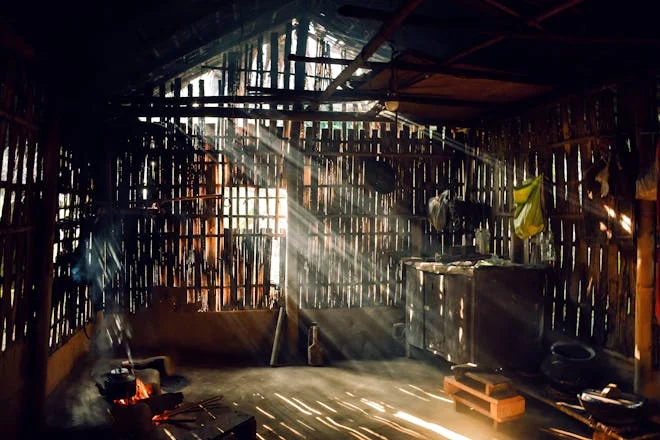
Imagery
Housman employs vivid imagery throughout the poem to create a sensory experience for the reader. Examples include:
- “The sun burns on the half-mown hill” – Visual imagery depicting the sun’s intensity on the partially cut hillside.
- “And Maurice amongst the hay lies still / And my knife is in his side” – Imagery of a person lying amidst hay with a knife in their side, evoking a sense of violence and tragedy.
- “And here’s a bloody hand to shake” – Visual and tactile imagery of a bloody hand, symbolizing farewell tinged with sorrow or conflict.
Symbolism
The poem is rich in symbolism, where certain elements represent deeper themes and emotions:
- “Farewell to barn and stack and tree” – The barn, stack, and tree symbolize the rural landscape and the speaker’s connection to nature and tradition.
- “Terence, look your last at me” – Terence symbolizes a personal connection or a specific individual to whom the farewell is addressed.
- “And oh, man, here’s good-bye” – The act of saying goodbye symbolizes the finality of departure and the emotions associated with it.
Enjambment
Housman utilizes enjambment, where sentences and phrases continue across line breaks, creating a smooth and flowing rhythm. For example:
- “Farewell to barn and stack and tree, / Farewell to Severn shore.” – The thought continues seamlessly from one line to the next, enhancing the poem’s musicality.
Caesura
Caesura refers to deliberate pauses within a line of poetry. Housman employs caesura effectively to add emphasis and rhythm. For instance:
- “The sun burns on the half-mown hill, / By now the blood is dried;” – The comma after “hill” creates a pause, drawing attention to the imagery of the sun and blood.
Alliteration
Alliteration, the repetition of initial consonant sounds, adds rhythm and emphasis. Examples include:
- “The sun burns on the half-mown hill” – Repetition of the “h” sound in “half-mown hill” creates a rhythmic pattern.
- “My mother thinks us long away” – Alliteration with the “m” sound in “mother” and “thinks” enhances the flow of the line.
Repetition
Repetition of phrases like “Farewell to” and “And long will” reinforces key themes and emotions, emphasizing the act of bidding farewell and its lasting impact.
Metaphor
Housman employs metaphors to convey deeper meanings, such as:
- “And oh, man, here’s good-bye; / We’ll sweat no more on scythe and rake” – The mention of sweating on scythe and rake metaphorically represents labor or toil, adding layers of meaning to the farewell.
Personification
There’s a subtle use of personification, attributing human qualities to non-human elements. For example:
- “Long for me the rick will wait” – The rick (stack of hay) is personified as waiting, creating a sense of anticipation or longing.
Contrast
The poem juxtaposes contrasting elements like beauty and violence, life and death, adding depth and complexity to the thematic exploration.
These literary and poetic devices enrich the poem, creating a multi-dimensional narrative that engages the reader on both emotional and intellectual levels.
Commonly Asked Questions
What is the central theme of “Farewell to Barn and Stack and Tree”?
The central theme of the poem is the irreversible nature of certain actions and the resulting sense of guilt and loss. It explores the emotional aftermath of a tragic event and its impact on the individual and those around them.
Who is Terence in the poem?
Terence is a character addressed by the speaker in the poem. He seems to be someone close to the speaker, perhaps a friend or a fellow worker, who is asked to witness the speaker’s final departure from his home.
Why does the speaker bid farewell to inanimate objects like the barn, stack, and tree?
The speaker bids farewell to these inanimate objects because they represent his former life and the world he is leaving behind. It’s a poetic way of expressing his detachment and the severing of ties with his past.
What is the significance of the Severn shore in the poem?
The Severn shore adds a specific geographical setting to the poem, grounding the speaker’s farewell in a tangible place. It also symbolizes the boundary between the speaker’s past life and his uncertain future.
Why doesn’t the poem provide a reason for Maurice’s death?
The lack of a clear reason for Maurice’s death adds to the poem’s universality and allows readers to focus on the emotional and psychological consequences of the act, rather than the specifics of the event itself.
What does the repetition of “long” in the final stanza signify?
The repetition of “long” emphasizes the enduring nature of the speaker’s absence and the lasting void that his departure will leave in his home and in the lives of those he leaves behind.
How does the poem’s structure contribute to its overall impact?
The poem’s structure, consisting of six quatrains with a consistent rhyme scheme, provides a rhythmic and predictable framework that contrasts with the chaotic emotions expressed in the poem, enhancing its impact.
Implications and Meanings of Farewell to Barn and Stack and Tree
Reflection on the Human Condition
The poem reflects on the human condition, particularly the themes of guilt, loss, and the irreversible consequences of one’s actions. The speaker’s farewell to familiar sights and loved ones signifies a broader contemplation of life’s fragility and the finality of certain choices.
The Inevitability of Change
Housman’s work often grapples with the inevitability of change, and this poem is no exception. The speaker’s departure from the Severn shore and the life he knew is a stark reminder that change is often sudden and irrevocable, leaving a lasting impact on those left behind.
The Isolation of Guilt
The speaker’s isolation is noticeable throughout the poem. His “bloody hands” are a metaphor for the guilt that separates him from his community and his own sense of self. This isolation is a powerful commentary on the loneliness that can accompany guilt and regret.
The Continuity of Life
Despite the tragedy, life continues—the fields need mowing, the rick and fold await, and the seasons change. This continuity is a bittersweet note in the poem, suggesting that while life goes on, the memories and consequences of our actions remain.
The Role of Nature
Nature serves as a backdrop to the human drama unfolding in the poem. The pastoral imagery contrasts with the violence of Maurice’s death, highlighting the indifference of nature to human suffering and the cycles of life and death that persist regardless of individual fates.
The Poem as a Commentary on Society
The poem can also be read as a commentary on society’s response to tragedy and wrongdoing. The speaker’s need to leave his home suggests a societal expectation for atonement and the difficulty of reconciliation after a grave mistake.
Emotional Resonance
Finally, the poem resonates emotionally with readers, inviting them to consider their own experiences of farewell, loss, and the consequences of their actions. It’s a universal exploration of themes that touch on the core of the human experience.
In summary, “Farewell to Barn and Stack and Tree” is a meditation on themes that are as relevant today as they were when Housman penned the poem. Its implications extend into psychology, philosophy, and social commentary, making it a rich subject for analysis and reflection.
Interactive Summary of Farewell to Barn and Stack and Tree
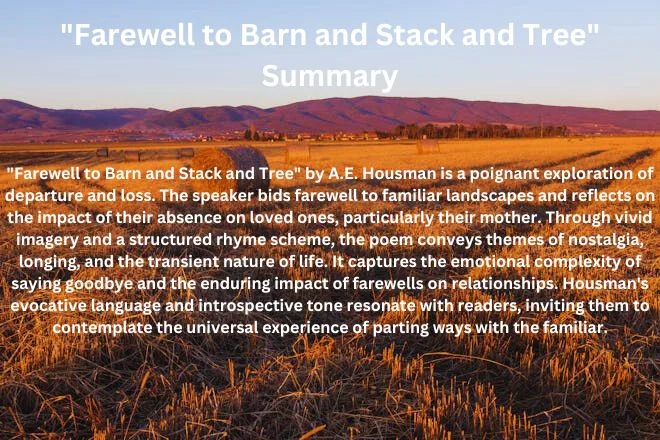
In essence, Housman’s timeless piece serves as a reminder of the beauty and melancholy inherent in moments of parting, resonating with audiences across generations.
Embark on an emotive journey through A.E. Housman’s “Farewell to Barn and Stack and Tree,” an exploration of departure and nostalgia. The poem’s vivid imagery, like the scorching sun on a half-mown hill and the symbolic Severn shore bidding adieu, evokes themes of loss and the relentless march of time.
Housman’s masterful use of literary devices enriches the narrative. The consistent rhyme scheme and seamless enjambment create a musical rhythm that echoes the speaker’s sentiments. Caesura and alliteration add depth, while metaphors and personification infuse the poem with emotional resonance.
At its heart, “Farewell to Barn and Stack and Tree” represents the human experience of saying goodbye and embracing change. Through Terence’s farewell and the imagery of blood-stained hands, we grapple with the complexities of farewells tinged with sorrow and resilience.
This prompts introspection, encouraging readers to reflect on their own encounters with farewells and their lasting impact. As you reflect on the poem’s exploration of guilt, change, and the human condition, consider how its messages resonate with your own experiences. What emotions does the poem stir in you? How do the images of the rick, the fold, and the cold dinner speak to the idea of absence?
If you connected with the emotional depth of “Farewell to Barn and Stack and Tree” by A.E. Housman, you may find similarities in themes with William Carlos Williams’ “This Is Just To Say.” Both poems delve into human emotions and relationships. Explore how “This Is Just To Say” offers reflections on regret and communication within relationships, complementing the themes found in Housman’s work.
RELATED POSTS
View all
